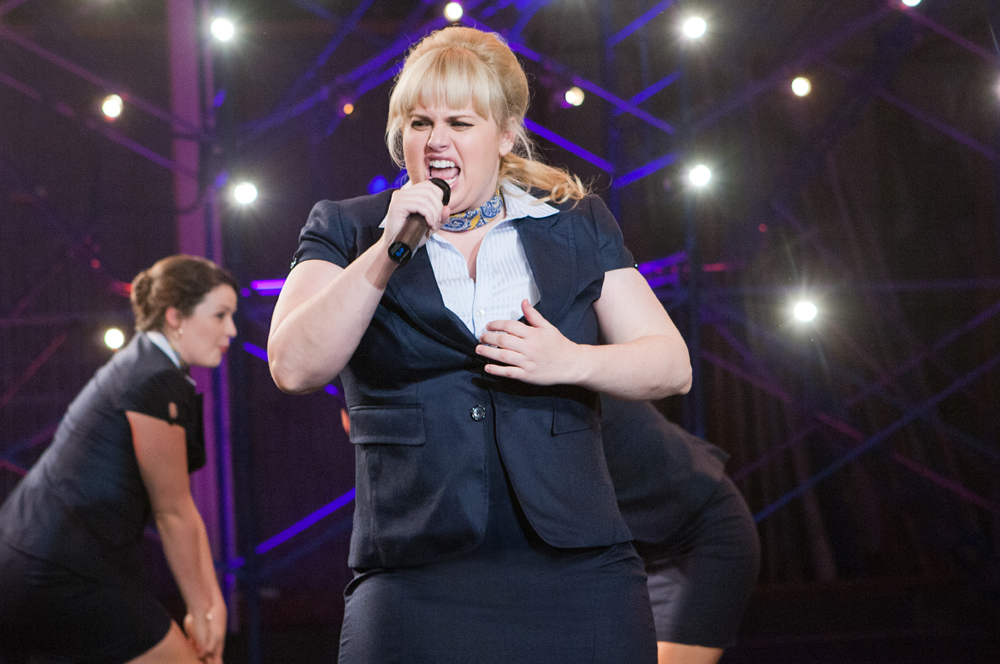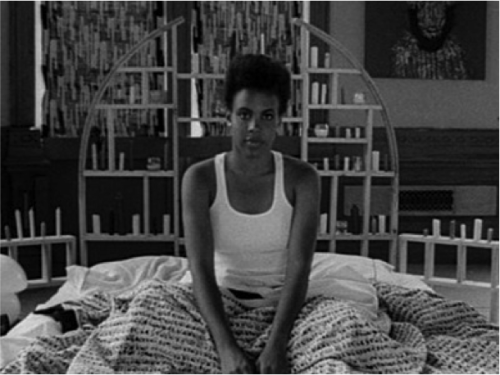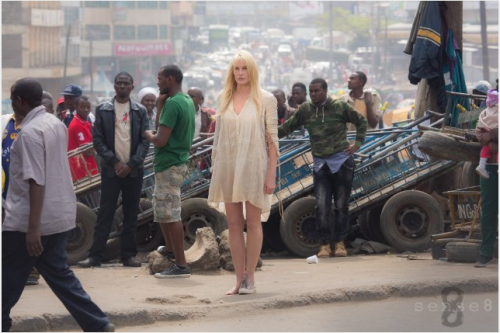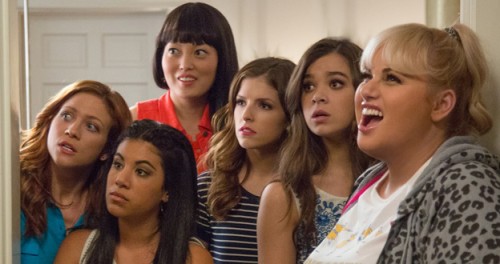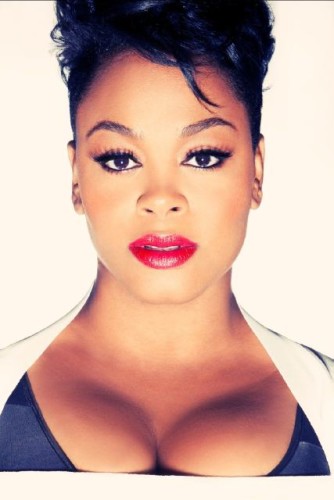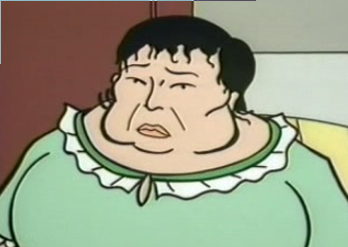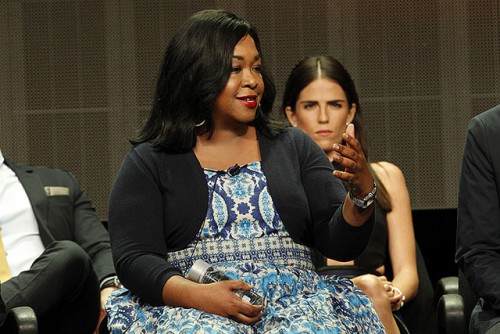This guest post written by Tessa Racked appears as part of our theme week on Unpopular Opinions. An earlier version of this essay appears on Consistent Panda Bear Shape. | Spoilers ahead for Pitch Perfect and Pitch Perfect 2.
I’ve been writing about film from an intersectional feminist perspective for a little over two years now; most of that writing is unpacking how fat characters function in film on my blog, Consistent Panda Bear Shape. Multiple patterns have been emerging from that work; there are three trends in particular that make it difficult for me to write from an intersectional and/or optimistic perspective. I don’t think, reader, that you will find them too surprising:
- Fat characters existing to receive the audience’s contempt, disgust, and/or pity. Mad Max: Fury Road is a great example, where the fat characters are autocrat Immortan Joe and his villainous ally, the People Eater, and the Milk Mothers, who exist as a grotesque example of how Immortan Joe objectifies and exploits the populace under his control.
- Likable fat characters having some workaround where they aren’t “actually” fat, so when the character finds confidence or asserts themselves, it can be a feel-good moment without leading the audience to question established standards of acceptable bodies on a broad social scale. Two common workarounds are embodied by Olive in Little Miss Sunshine. While her story revolves around her transgression of physical beauty standards, these standards only apply to the strict, hyperfeminine pageant world; outside that context, her body is within the range of social acceptability. Additionally, actor Abigail Breslin wore a fat suit for the role, further disconnecting Olive’s story from the lived experiences of fat people.
- Fat protagonists who are “actually” fat being men, usually of the straight, white variety. Of the 62 films featuring fat characters that I’ve written articles about thus far: 41 of the predominant fat characters were male, 35 of those male characters were white, and only 3 of them were identified as queer within the text of the film. Of the 2 non-human fat characters referred to male in their respective screenplays, both were voiced by white men. (The films I write about haven’t been curated in an objective manner, so take this anecdata with a grain of salt.)
The movies that I watch utilize at least one of these patterns time and time again, if they include fat characters at all. Considering this, when I do see a film featuring a decently-written character in a plot-significant role who is played by a fat actor and isn’t a straight white dude, I start having hopes for a bold new cinematic vision wherein fat people aren’t treated like garbage. Pitch Perfect is a perfect example of the kind of film that will stoke the flames of my high expectations, featuring Rebel Wilson as Fat Amy. When it was making its way into theaters, I remember seeing this exchange all over Tumblr:
This exchange says everything about why I and many others were excited: a female character, played by someone who looks like she gets relegated to the same measly section of clothing stores that I do, being funny and unapologetic about how she gets treated based on her size. (And on a more personal note, Fat Amy is also the cover girl for an AV Club article about humanized portrayals of fat characters that was an inspiration for Consistent Panda Bear Shape.) However, I didn’t actually get around to watching Pitch Perfect until it and its sequel, Pitch Perfect 2, were already out on DVD. I’ve seen a lot of positive press around Fat Amy, but for me, the viewing experience of the two films back-to-back was overall a four-hour anti-climax to my hopes for a new approach to fat representation in a mainstream comedy.
It isn’t all bad. There are some significantly refreshing aspects to how Fat Amy is represented, especially in the original movie. Where a fat body is often employed as visual shorthand for incompetence, she proves her ability as a singer in her introductory scene, impressing Aubrey (Anna Camp) and Chloe (Brittany Snow) with her voice despite their focus on finding women with “bikini-ready bodies” to audition for the Barden Bellas a capella choir. She is also the most self-assured of the Bellas by far. Her sense of humor is often outlandish but her deadpan delivery suggests that she gets more out of confusing the other characters than entertaining them. The majority of comments characterizing Fat Amy as fat are self-referential but, surprisingly, not self-deprecating. She casually remarks at her surprise that her “sexy fat ass” was chosen to be part of the Bellas. Fatness is part of how she sees herself, and isn’t a source of shame or something that needs to be sanitized; rather, it’s a part of her identity that she modifies appropriately to her mood and context. It felt oddly empowering as a fat viewer to hear her angrily threaten to “finish [someone] like a cheesecake.” Another detail that resonated with me was her fearlessness at calling attention to her body. She sprawls and flails. She has a habit of nonchalantly slapping a rhythm on her belly — a woman having fun with her fat! imagine! — or cupping her breasts during a performance. She inhabits her body and her personal space without apologizing or minimizing.
Beyond how Fat Amy is portrayed as an individual, Pitch Perfect also has progressive aspects to how Fat Amy functions as part of the Bellas. As opposed to what one might expect from a fat character in an ensemble cast, Pitch Perfect doesn’t put Fat Amy in a position where she drags the group down. There is a requisite joke about her avoiding physical activity (while the other singers jog, Aubrey finds Fat Amy lying down, or as she calls it, “horizontal running”), but her sloth seems less sinful in contrast to Aubrey’s drill sergeant seriousness about their shared extracurricular activity. Instead, both films focus on Beca (Anna Kendrick) as the problematic member of the group due to her lack of commitment. As a group, the Bellas have to deal with a change in their image from normatively attractive young women to one that includes singers who don’t meet stereotypical sorority girl standards. They are the classic rag-tag underdogs in a story focuses on competition. “I wanted the hot Bellas,” complains a frat brother who books the group to perform at a mixer, when shutting them down mid-song, “not this barnyard explosion.” Even the senior Bellas, thin and preppy Aubrey and Chloe, have bodies that defy expectations of femininity. It’s common to see fat female characters in comedies as a focal point of gross or bizarre body humor, but Pitch Perfect takes a more democratic approach. Aubrey struggles with stress-induced projectile vomiting, and soprano Chloe gains the ability to sing deep bass notes after a surgery to remove nodes on her vocal cords.
Although Fat Amy isn’t presented as more grotesque or cartoonish than the other characters, Pitch Perfect doesn’t extend the favor to other Bellas who aren’t straight and white, as Fat Amy is. The most glaring contrast is Cynthia Rose (Ester Dean), a Black butch lesbian (with an incredible set of pipes) who is also larger-bodied than the average young woman seen in a mainstream comedy. We first meet her at auditions, where she is immediately misgendered. She doesn’t come out as gay to her chorus mates until towards the end of the movie, although we get “hints” to her sexuality via shots of her leering at or groping other women, or other characters making snide comments about her sexual orientation and/or gender presentation. The audition sequence where we meet Cynthia Rose also introduces Lilly (Hana Mae Lee), who embodies the stereotype of the quiet Asian girl through a running gag where she says disturbing things in a soft voice that none of the other characters are able to hear.
Although all of the characters are part of the same underdog team, mining tired caricatures for humor reifies divides in the group via racism and homophobia. And while Fat Amy transgresses stereotypes about fat women, she is straight and white, which within the world of the film, puts her in an uncriticizable position to make snarky comments about Cynthia Rose’s sexuality and other uncomfortable remarks at the expense of marginalized groups (e.g. a clunky improv moment referring to her hairstyle as an “Orthodox Jew ponytail”).
The “fat positive” aspects of Fat Amy’s depiction aren’t just positioned against other characters who don’t share her privileged social identities. Stacie’s (Alexis Knapp) function in the group as the humorously promiscuous Bella complicates the praise Pitch Perfect gets for showing Fat Amy’s active sex life. Stacie’s sexuality is coded as excessive, a joke that becomes the majority of her screen time, whether Aubrey is trying to get her to tone down her dance moves or she’s referring to her vagina as a “hunter.” However, we never see Stacie involved with anyone. Fat Amy, on the other hand, is shown in the company of two hunks on her spring break and also makes comments about her own sexual prowess. So why is the line drawn between Stacie and Fat Amy, where one’s sexuality is the butt of jokes and the other’s is an empowering aspect of her character? When we see Bumper (Adam Devine) flirting with Fat Amy and getting shot down or hear Fat Amy talk about how she joined the Bellas because she needed to step back from her busy love life, we see her defying the expectations that we have for fat girls in movies, the assumption that nobody will want to have sex with her or that she won’t have the confidence to approach someone. Stacie, however, is thin and normatively attractive. The audience expects that she has no shortage of willing sexual partners and doesn’t restrain herself in the way she is expected to; thus, she is deserving of ridicule. The inconsistency between how the two characters’ sex lives are valued demeans Stacie and condescends to Fat Amy.
As Pitch Perfect 2 is helmed by a female director and writer with some skin in the game (Elizabeth Banks, who is in a supporting role in both films, and Kay Cannon, who wrote the original), one might hope that the sequel would amend the issues in the original, perhaps by giving more screen time to find some depth in characters like Cynthia Rose and Lilly. Unfortunately, the franchise loses more feminist cred by doubling down on the cheap stereotypes. Cynthia Rose is still a source for jokes about lesbians creeping on straight women, Lilly is still the quiet Asian girl, and now Flo (Chrissie Fit) has joined the Bellas, a Latina woman whose every comment is about how harsh and dangerous her life was in her unspecified Latin American home country.
Even the progressive aspects of Fat Amy’s depiction in Pitch Perfect largely erode in the sequel. The opening sequence is perhaps the most telling, where Fat Amy experiences a costume malfunction during a performance at President Obama’s birthday gala and accidentally exposes her vulva to the TV cameras and the concert audience. Typical to a comedy film, the audience reacts with disgust and terror, some even running away. Although unintentional, her body is deemed excessive and the resulting outcry nearly destroys the Bellas.
A similar scene of disgust comes later in the film, where a romantic moment between Fat Amy and Bumper (Adam Devine) causes his friends to run away in order to avoid looking at the couple. (While Bumper isn’t as outside the normative range of bodies seen on-camera, he is larger-bodied than the other Treblemakers.) The plotline of their relationship doesn’t meet the standards of a romantic partner that Fat Amy sets in the first film, where she brushes off his advances (though she raises the eyebrows of the other Bellas by having his number in her phone). In Pitch Perfect 2, she and Bumper are hooking up. He asks her to date him officially with a romantic dinner; she initially turns him down, saying that she’s a “free range pony who can’t be tamed,” but eventually realizes that she’s in love with him (for no discernible reason) and wins him back with a rendition of Pat Benatar’s “We Belong.” The main conflict of Pitch Perfect is the competition between the Bellas and the Treblemakers, which sets up Fat Amy and Bumper as well-balanced adversaries, both confident and ambitious. Fat Amy disdains Bumper’s advances and flirts with aforementioned hunks; Bumper quits school for an opportunity to work for John Mayer. However, in the second film, former antagonist Bumper has been humbled, now working as a college security guard and desperately trying to hang on to his past glory days as a college a capella big shot. It is at this point that he becomes a suitable partner for Fat Amy.
In Pitch Perfect, the Bellas achieve a competitive edge by using Beca’s mash-up arrangements instead of more traditional medley formats in their performances. This works as an apt allegory for Pitch Perfect as feminist films: there are some welcome updates, but ultimately it’s the same song. It’s great to see a character whose fatness is a part of her identity without being a point of dehumanization, but the films try to make Fat Amy likable at the expense of other characters, positioning her as acceptably quirky, in contrast to the women of color, who are portrayed in a more two-dimensional manner, or Stacie, who is unacceptable due to her promiscuity. Ultimately, the underlying current of stereotype-based humor puts the film’s fat positivity in a dubious light, compounded by the erosion of Fat Amy’s status as kickass fat girl, as well as any thematic content about female friendship.
See also at Bitch Flicks:
Pitch Perfect and Third Wave Feminism
Tessa Racked can be heard as a guest contributor to film podcasts including Directors Club and Tracks of the Damned, on the Now Playing Network. They are good at modern dance, olden dance, mermaid dancing, and peppering the Internet with cleverness. You can follow them on Twitter @tessa_racked.
